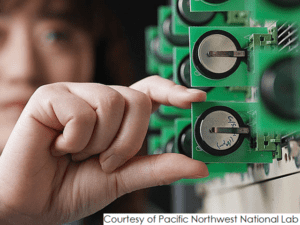
Nanotechnology is science at the nanoscale, working at the atomic or molecular level of matter. A nanometer is one billionth of a meter — invisible to the eye. Nanotechnology is being used to innovate in many different fields including medicine, the environment, technology, and energy storage. The concept of nanoscience first started in 1959 when physicist Richard Feynman spoke about manipulating and controlling individual atoms and molecules. The field as we now know it began in 1981, when the scanning tunneling microscope was developed, which allowed scientists to see individual atoms and begin research at the nanoscale. In the battery industry, many companies are working to incorporate nanotechnology into batteries and battery production processes in hopes of improving material mining and battery performance and capacity.
How is nanotechnology improving material mining?
Lithium is currently the most coveted material needed for batteries. With the continuous growth of portable technology and EVs, and an increasing need for energy storage, analysts predict that the demand for lithium will increase tenfold by 2029. 70% of lithium is mined via brine extraction, which involves pumping salt-rich waters into a series of evaporation ponds. The water evaporates and pure lithium is eventually extracted from the ponds. However, this process is not only water-intensive, affecting the water supply to nearby residents and farmers, but also only extracts 30 to 50% of the available lithium.
One company is working to make use of nanotechnology to improve the efficiency of this process. EnergyX makes use of a nanotechnology called Metal Organic Framework (MOF) to separate lithium from the other materials in the water. An MOF is a porous material, consisting of metal ions and organic ligands that form a cage-like structure. They can act like a sieve to segregate materials, which is how EnergyX is making use of it. The small pores of the MOF allow lithium to pass through, but stop other ions like magnesium or calcium, allowing for a more efficient way to extract lithium. The company designed their technology to incorporate into the current brine ponds system, maximizing the mining process. Creating more efficient, sustainable, and environmentally-friendly mining processes can be a big help in meeting the demand for lithium and other battery materials
How is nanotechnology improving batteries?
There are currently numerous projects around using nanotechnology to create better batteries. These range from increasing the surface area of electrodes in order to increase capacity to improving the safety and stability of the battery.
The advanced materials company TruSpin Nanomaterial Innovation makes use of silicon nanofibers to increase the energy capacity of lithium-ion batteries. Silicon has long been a favored choice as a battery anode because of its high ion-carrying capacity. However, due to its tendency to expand and shatter throughout charge/discharge cycles, manufacturers are facing difficulties in incorporating it into a battery. Nanotechnology can help to address this issue. By using nanofibers, TruSpin is able to work around these expansion issues, and make the manufacturing process highly scalable and cost-efficient.
Amprius is another company leveraging nanotechnology to make silicon more usable for batteries. They designed egg-like capsules to protect the silicon from reacting negatively with the electrolyte, which causes the anode to develop a non-conductive solid-electrolyte interphase layer and reduces capacity. The structure also gives room for the silicon to expand and contract safely. In their design, a silicon nanoparticle is surrounded by a highly conductive carbon shell that lithium ions could pass through. With this configuration, their team found that the anode still retained 74% of its capacity after 1000 charge/discharge cycles.
Pure lithium metal is also a highly favored battery material. However, since it is highly reactive, dendrites tend to form on the surface of the anode, creating branch-like structures that can pierce and damage the battery. To counteract this, scientists at Rice University made use of carbon nanotube film to coat the lithium metal foil. The coating discourages li-ions from latching onto the lithium metal anode and prevents dendrite growth.
Despite its miniscule size, nanotechnology has the potential to make big waves in battery development, research, and manufacturing. Good, high quality battery test equipment allows researchers to notice patterns and gaps in a battery’s performance, and discover areas which nanotechnology could potentially help to fill.


